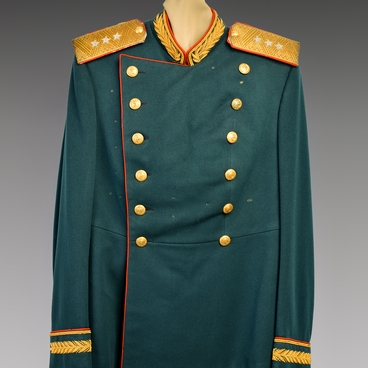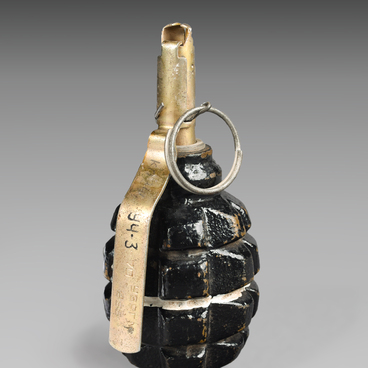The ‘Guards’ badge was established by the Decree of the Presidium of the Supreme Soviet of the USSR ‘On the introduction of Guards ranks for soldiers of Guards units and formations of the Red Army and Navy’ on May 21, 1942.
In wartime, the ceremony of awarding Guard badges was held in a solemn atmosphere — there was a common formation with the presentation of the unit’s banner. Only military personnel who took part in fighting could be awarded it. As a rule, the record of the issue of the badge was entered in the Red Army Soldier ID.
The “Guards” badge on display in the museum belonged to Nikolai Zakhvatayev, a resident of the village Gari of the Malmyzhsky Uyezd of the Vyatka Governorate (Kirov Region).
Zakhvatayev took part in the First World War. He joined the Red Army in 1918 and took part in the battles of the Civil War. In 1930, he finished an officer training course of the Red Army “Vystrel”, in 1935, he graduated from the Frunze Military Academy and in 1939 — from the Academy of the General Staff of the Red Army. Zakhvatayev held several command positions and also taught at the Department of Tactics of the Military Academy of the General Staff.
In June 1941, he went to the front of the Great Patriotic War. He served as Commander of Staff of Operational Division of the Southwestern Front, and from November 1941 to May 1942 — Commander of Staff of the 1st Shock Army. From May 1944 to February 1945, Zakhvatayev commanded the rifle corps and then the troops of the 1st Shock Army and the 4th Guards Army.
On April 26, 1945, the Presidium of the Supreme Soviet of the USSR awarded Nikolai Zakhvatayev the title Hero of the Soviet Union for his skillful management of troops during the liberation of Hungary and Vienna and also his courage and heroism.
In the post-war time, Zakhvatayev went on commanding various military formations. In 1957-1960s, he was appointed a military adviser of the Hungarian People’s Army. In 1960, he retired with the rank of Guards Colonel-General. He died on February 15, 1963. One of the streets in Kirov is called after Nikolai Zakhvatayev.
In wartime, the ceremony of awarding Guard badges was held in a solemn atmosphere — there was a common formation with the presentation of the unit’s banner. Only military personnel who took part in fighting could be awarded it. As a rule, the record of the issue of the badge was entered in the Red Army Soldier ID.
The “Guards” badge on display in the museum belonged to Nikolai Zakhvatayev, a resident of the village Gari of the Malmyzhsky Uyezd of the Vyatka Governorate (Kirov Region).
Zakhvatayev took part in the First World War. He joined the Red Army in 1918 and took part in the battles of the Civil War. In 1930, he finished an officer training course of the Red Army “Vystrel”, in 1935, he graduated from the Frunze Military Academy and in 1939 — from the Academy of the General Staff of the Red Army. Zakhvatayev held several command positions and also taught at the Department of Tactics of the Military Academy of the General Staff.
In June 1941, he went to the front of the Great Patriotic War. He served as Commander of Staff of Operational Division of the Southwestern Front, and from November 1941 to May 1942 — Commander of Staff of the 1st Shock Army. From May 1944 to February 1945, Zakhvatayev commanded the rifle corps and then the troops of the 1st Shock Army and the 4th Guards Army.
On April 26, 1945, the Presidium of the Supreme Soviet of the USSR awarded Nikolai Zakhvatayev the title Hero of the Soviet Union for his skillful management of troops during the liberation of Hungary and Vienna and also his courage and heroism.
In the post-war time, Zakhvatayev went on commanding various military formations. In 1957-1960s, he was appointed a military adviser of the Hungarian People’s Army. In 1960, he retired with the rank of Guards Colonel-General. He died on February 15, 1963. One of the streets in Kirov is called after Nikolai Zakhvatayev.

